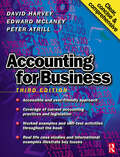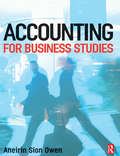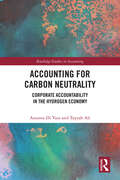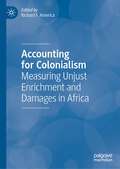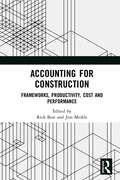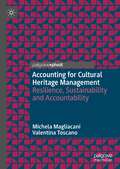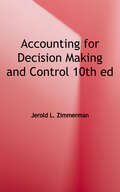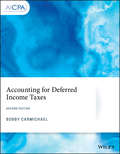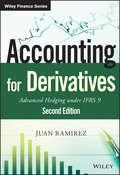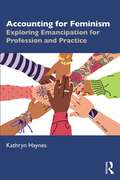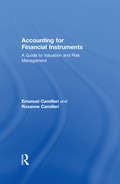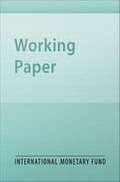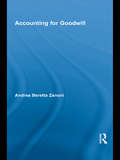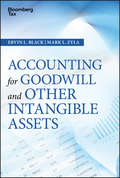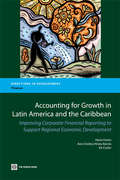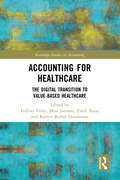- Table View
- List View
Accounting for Business
by David Harvey Peter Atrill Edward McLaney'Accounting for Business' is ideal for undergraduate students on business and accounting courses who need to understand the nuts and bolts of financial accounting. This popular textbook has always enjoyed a deserved reputation for accessibility and thoroughness. Now in its third edition, its contents have been fully updated and restructured to make them even easier to use. Readers will benefit from the coverage of current accounting practices and legislation, in addition to the range of worked examples and self-test activities throughout the book. 'Accounting for Business' clearly explains accounting information's role in making sound business decisions and focuses upon the aspects of accounting practice which are most relevant to the non-specialist manager. It is ideal for first year undergraduates of business studies, higher students and those pursuing professional accountancy qualifications.This third edition has been restructured, to further enhance its 'student centred' approach. The content has now been broken down into 25 roughly equivalent 'bite-sized' individual study topics. Each of these requires 6 hours of study time, enabling this book to support a full scale semester course with two topics a week, or a full year course at one topic a week. Includes a wide selection of topical case studies, with a broad spread of international examples.
Accounting for Business Combinations: Acquisition Method
by David F. Hawkins F. Asis Martinez-JerezA technical note reviewing business combinations and Goodwill accounting, under the Statement of Financial Accounting Standards, No. 141R.
Accounting for Business Studies
by Aneirin OwenBusinesses are complex, and, as a result, teachers face a difficult task developing students' understanding of how they work, especially in the global context. Accounting for Business Studies helps teachers focus on modern commercial issues and integrates accounting into business and management studies. This book includes: * A business perspective rather than an accounting perspective* e-business, including case studies* Globalisation, including case studies* Business skills, like interpretation, analysis and communication* IT integrated into specific business situations* Includes models such as Porter's Five Forces, Supply Chain, Product Life Cycle
Accounting for Carbon
by Bellassen, Valentin and Stephan, Nicolas Valentin Bellassen Nicolas StephanThe ability to accurately monitor, record, report and verify greenhouse gas emissions is the cornerstone of any effective policy to mitigate climate change. Accounting for Carbon provides the first authoritative overview of the monitoring, reporting and verification (MRV) of emissions from the industrial site, project and company level to the regional and national level. It describes the MRV procedures in place in more than fifteen of the most important policy frameworks - such as emissions trading systems in Europe, Australia, California and China, and the United Nations Framework Convention on Climate Change - and compares them along key criteria such as scope, cost, uncertainty and flexibility. This book draws on the work of engineers and economists to provide a practical guide to help government and non-governmental policy makers and key stakeholders in industry to better understand different MRV requirements, the key trade-offs faced by regulators and the choices made by up-and-running carbon pricing initiatives.
Accounting for Carbon Neutrality: Corporate Accountability in the Hydrogen Economy (Routledge Studies in Accounting)
by Assunta Di Vaio Tayyab AliDespite the progress made so far, the links between environmental, social and governance (ESG) sustainability pillars remain underexplored, particularly in the context of firms investing in hydrogen for decarbonization. In essence, hydrogen is a lynchpin connecting engineering ingenuity, economic viability, and strategic business decisions. Its multifaceted role underscores its significance in addressing contemporary challenges, driving innovation, and shaping a sustainable future through the accounting system.This book unravels the complexities of carbon control practices, offering insights into financial, operational, and sustainable dimensions. From the challenges of sustainability transitions and technology adoption to utilize renewable resources and disclosing decarbonization practices, the book explores the critical role of accounting tools and international regulatory frameworks like the United Nations 2030 Agenda, the European Union Green Deal, and Paris Agreement as organizational collective responsibility in shaping a sustainable future.By incorporating stakeholder, stewardship, legitimacy, institutional, resource dependency theories, the book bridges gaps in academic research and offers a fresh perspective on decarbonization in the hydrogen sector. The qualitative methodology provides a unified vision from strategies to implementation, guiding companies toward the contribution of the carbon neutrality goal in the hydrogen economy while ensuring accountability for their actions, conduct, and sustainability reporting.
Accounting for Colonialism: Measuring Unjust Enrichment and Damages in Africa
by Richard F. AmericaThis book examines qualitatively and quantitatively the exploitation of African through colonialism and imperialism. The contribution included build on previous qualitative analyses of the effects of imperialism and colonialism in Africa. Chapters expand on that body of work and introduce new ways to measure some of the benefits that accrued to Europe and North America through centuries of systematic underpayments and overcharges that one can consider abuse of dominance. The collection also adds to an ongoing process that is related to the growing work related to reparations. This book, thereby, contributes to a process of changing international development assistance policy. It helps to create a basis for officially estimating the continuing gains from past and current actions against African economic, social, and political institutions and systems. This edited volume, which showcases a diversity of scholars and their perspectives, attempts to establish wrongful benefits and damages from almost 600 years of international harm to the African continent.
Accounting for Construction: Frameworks, Productivity, Cost and Performance
by Rick Best Jim MeikleAccounting for Construction follows on from Measuring Construction, edited by the same team. It extends the coverage of some of the material in the first volume and expands the range of related topics to include, inter alia, shadow economies, accounting for informal construction and the treatment of the built environment sector in national accounts. Taken together, the two volumes collate a range of topics that are only addressed, if addressed at all, in occasional academic papers and the publications of bodies such as national statistical offices and the World Bank. Accounting for Construction presents international examples from the UK, Australia and New Zealand and from both academic and professional contributors. This book is essential reading for all researchers and professionals interested in construction economics, construction management, and anyone interested in how the construction industry affects the global economy in ways previously under-represented in the literature.
Accounting for Cultural Heritage Management: Resilience, Sustainability and Accountability
by Michela Magliacani Valentina ToscanoThe transformative role of culture, its ability to create value for the benefit of current and future generations, is widely recognized by academics of many disciplines, professionals and policymakers. Notwithstanding, how culture can be a driving force for economic growth, a source of welfare and tools for social inclusion, still deserves to be investigated at various levels, starting with local communities. This book attempts to explain the relevance of accounting knowledge for managing cultural heritage by sustainable, resilient, accountable organizations, regardless of their public or private institutional form. This book aims at understanding the role of cultural heritage in the economy, in society and in facing the new challenges deriving from the enactment of the UN Sustainable Development agenda, as well as the pandemic emergency from COVID-19. It adopts a managerial accounting studies approach to provide answers that can be applied in any organizational context. The results achieved from the field research are critically discussed under the theoretical frameworks referring to the theory of value and its creation. From the findings and their discussion, a conceptual model based on empiricism is proposed for managing cultural heritage of communities under sustainable perspective, even in times of crisis. It will be essential reading for academics and students of cultural heritage management, sustainability and crisis management in organisations.
Accounting for Current Assets
by William J. Bruns Jr.An introduction to accounting for current assets: receivables, inventories, and other current assets. Included are discussions of FIFO, LIFO, average cost, and explanation of accounting for manufactured inventories. To be assigned with cases on inventory valuation as an introduction to current assets.
Accounting for Decision Making and Control
by Jerold L. ZimmermanAccounting for Decision Making and Control provides students and managers with an understanding appreciation of the strengths and limitations of an organizations accounting system, thereby allowing them to be more intelligent users of these systems. Zimmerman provides students with a framework for understanding accounting systems and a basis for analyzing proposed changes to these systems. <p><p> Consistent with prior editions, the goal of the new 10th edition of Zimmerman strives to demonstrate to students that Managerial Accounting is an integral part of the firm’s organizational architecture, not just an isolated set of computational topics.
Accounting for Deferred Income Taxes (AICPA)
by Bobby CarmichaelA complicated accounting model, FASB ASC 740 has been around for a while. But the rules are becoming more challenging as businesses become more complex. This book incorporates the new tax rates and other impacts of the Tax Cuts and Jobs Act and will assist you in understanding FASB ASC 740, Income Taxes, and how it establishes guidelines for accounting for income taxes, including income tax expense, classification of deferred tax accounts, and related disclosures.Key topics include: Principles of FASB ASC 740 Income tax expense and deferred tax liabilities and assets Valuation allowances Proper documentation of deferred income taxes in the work papers Required disclosures within the financial statements
Accounting for Derivatives
by Juan RamirezAccounting for Derivatives: Advanced Hedging under IFRS is a comprehensive practical guide to hedge accounting. This book is neither written by auditors afraid of providing opinions on strategies for which accounting rules are not clear, nor by accounting professors lacking practical experience. Instead, it is based on day-to-day experience, advising corporate CFOs and treasurers on sophisticated hedging strategies. It covers the most frequent hedging strategies and addresses the most pressing challenges that corporate executives find today.The book is case-driven with each case analysing in detail a real-life hedging strategy. A broad range of hedging strategies have been included, some of them using sophisticated derivatives.The objective of this book is to provide a conceptual framework based on the extensive use of cases so that readers can create their own accounting interpretation of the hedging strategy being considered. Accounting for Derivatives will be essential reading for CFOs, internal auditors and treasurers of corporations, professional accountants as well as derivatives professionals working at commercial and investment banks.Key feature include:The only book to cover IAS39 from the derivatives practitioner's perspectiveExtensive real-life case studies to providing essential information for the practitionerCovers hedging instruments such as forwards, swaps, cross-currency swaps, and combinations of standard options as well as more complex derivatives such as knock-in forwards, KIKO forwards, range accruals and swaps in arrears.Includes the latest information on FX hedging and hedging of commodities
Accounting for Employee Stock Options
by Mark T. BradshawEmployees who have been granted stock options have the right to purchase shares of their company's stock at a specified price within a specified time period. The accounting for such employee stock options has been a controversial and complex topic for decades. The debate has continued to the present time because of the high visibility of company executives who have made fortunes under their stock option programs. This note chronicles the history and debate surrounding the rules for stock options accounting and provides a simple, instructive example of accounting entries for fixed stock option grants.
Accounting for Feminism: Exploring Emancipation for Profession and Practice
by Kathryn HaynesAlthough gender challenges in accounting are widely acknowledged, research often addresses the position of men and women in relation to various issues, without necessarily challenging the underlying structures and social constructions of gender. In contrast, this book takes a much more overtly feminist position, informed by feminist theory, feminist methodology and feminist activism, to challenge these constructs and resulting inequalities. The book addresses contemporary global feminisms and their potential emancipatory implications for accounting, as a profession and as a tool or technology.It explores feminist theorisations of accounting, offering new insights into their relevance, and provides a rich theoretical and practical resource to advance knowledge in the discipline and stimulate further interdisciplinary research. Rather than being issue driven with chapters organised to address particular concerns that relate to gender and accounting, such as parenthood, career progression, accountability, etc., the structure of this book is such that the feminist theoretical position is the starting point for each chapter. The book highlights the range of ways that feminism, in its various forms and from numerous theoretical perspectives, can contribute to an understanding of the challenges relating to gender, race and class occurring within accounting, and the ways of overcoming them.In this way, the book provides an integrated discussion of feminist theories and the emancipatory potential of applying them to accounting that will appeal to readers whatever their orientation to feminism.
Accounting for Financial Instruments: A Guide to Valuation and Risk Management
by Emanuel Camilleri Roxanne CamilleriAccounting for Financial Instruments is about the accounting and regulatory framework associated with the acquisition and disposal of financial instruments; how to determine their value; how to manage the risk connected with them; and ultimately compile a business valuation report. Specifically, the book covers the following topics, amongst others: Accounting for Investments; Bills of exchange; Management of Financial Risks; Financial Analysis (including the Financial Analysis Report); Valuation of a business (including the Business Valuation Report) and Money laundering. Accounting for Financial Instruments fills a gap in the current literature for a comprehensive text that brings together relevant accounting concepts and valid regulatory framework, and related procedures regarding the management of financial instruments (investments), which are applicable in the modern business world. Understanding financial risk management allows the reader to comprehend the importance of analysing a business concern. This is achieved by presenting an analytical framework to illustrate that an entity’s performance is greatly influenced by its external and internal environments. The analysis of the external environment examines factors that impact an entity’s operational activities, strategic choices, and influence its opportunities and risks. The analysis of the internal environment applies accounting ratio analysis to an entity’s financial statements to examine various elements, including liquidity, profitability, asset utilisation, investment, working capital management and capital structure. The objective of the book is to provide a fundamental knowledge base for those who are interested in managing financial instruments (investments) or studying banking and finance or those who wish to make financial services, particularly banking and finance, their chosen career. Accounting for Financial Instruments is highly applicable to both professional accountants and auditors and students alike.
Accounting for Frequent Fliers
by William J. Bruns Jr. Susan S. HarmelingAirline frequent flier programs offer members the opportunity to earn free flights by accumulating mileage. Accounting and reporting the obligations of airlines and the cost of frequent flier programs raises difficult measurement issues. In 1991, the U.S. Securities and Exchange Commission began to require airlines to disclose the number of free flights program members took. The case allows estimates of the cost and obligations of the United Air Lines program.
Accounting for Global Dispersion of Current Accounts
by Jaewoo Lee Yongsung Chang Sun-Bin KimAccounting for Global Dispersion of Current Accounts
Accounting for Goodwill (Routledge Studies in Accounting #6)
by Andrea Beretta ZanoniThis book provides an illuminating analysis of Internally Generated Goodwill from a strategic point of view. The author launches his strategic analysis from a foundational understanding of Internally Generated Goodwill as determined largely in relationship to intangible resources and competitive differentials. Arguing that intangible resources are at the origin of competitive differential--and accordingly at the origin of the achievement of economic profit--the author shows how Internally Generated Goodwill can be considered as the economic expression of competitive differentials and, therefore, as the expression of the greater firm’s value that originates from those differentials. In addition to offering this innovative theoretical framework, the author develops a variety of practical tools for generating value estimates and value breakdowns of IIG. The masterful analysis provided here focuses on developing methods for identifying the elements that compose IIG and on achieving an accurate estimate of its value, ultimately seeking to evaluate the limitations and advantages of the existing variety of approaches to analyzing the constituent parts of IIG and to devise accounting practices that will help academics and professionals alike to obtain more significant and lucid results.
Accounting for Goodwill and Other Intangible Assets (Wiley Corporate F&A)
by Mark L. Zyla Ervin L. BlackConcepts, methods, and issues in calculating the fair value of intangibles Accounting for Goodwill and Other Intangible Assets is a guide to one of the most challenging aspects of business valuation. Not only must executives and valuation professionals understand the complicated set of rules and practices that pertain to intangibles, they must also be able to recognize when to apply them. Inside, readers will find these many complexities clarified. Additionally, this book assists professionals in overcoming the difficulties of intangible asset accounting, such as the lack of market quotes and the conflicts among various valuation methodologies. Even the rarest and most problematic situations are treated in detail in Accounting for Goodwill and Other Intangible Assets. For example, the authors analyze principles for identifying finite intangible assets and appropriately accounting for amortization expenses or impairment losses. Using the information in this book, the results of these calculations can also be reported with precision on financial statements. These topics are especially important for ensuring the success of any asset acquisition or business combination. In these special cases, the utmost accuracy is essential. This book provides: Rules for identifying and recognizing intangible assets in business combinations and asset acquisitions Guidance on the accurate valuation and carrying amount calculation of acquired and self-created intangibles Tips for overcoming the challenges unique to intangible assets, including impairment testing Clear instructions for disclosing intangible assets, goodwill, and amortization expenses Accounting for Goodwill and Other Intangible Assets is an indispensable reference for valuation students and specialists. Ervin L. Black and Mark L. Zyla provide thorough instructions for understanding, accounting for, and reporting this challenging asset class.
Accounting for Growth in Latin America and the Caribbean
by Ana Cristina Hirata Barros Henri Fortin Kit CutlerThe importance of moving toward high-quality, global standards of accounting and auditing has never been clearer. In the midst of the global financial and economic crisis, the leaders of the Group of 20 met and issued their "Declaration on Strengthening the Financial System", placing significant emphasis on sound accounting and auditing standards as a critical piece of the international financial architecture. Transparent and reliable corporate financial reporting underpins much of the Latin America and Caribbean development agenda, from private-sector-led growth to enhanced financial stability, facilitating access to finance for small and medium enterprises, and furthering economic integration. For nearly 10 years, the World Bank has prepared diagnostic Reports on the Observance of Standards and Codes (ROSCs) on Accounting and Auditing (A and A) at the country level. In Latin America and the Caribbean, ROSC A and A reports have been completed for 17 countries. This book takes a step back and seeks to distill lessons from a regional perspective. 'Accounting for Growth in Latin America and the Caribbean' is the first book to examine financial reporting and auditing in the region in a systematic way, drawing on the World Bank's years of experience and analysis in this area. The book is designed to inform the policy dialogue on accounting and auditing issues among government officials, the accounting profession, the private sector, academia, and civil society in LAC countries. It also seeks to disseminate the lessons learned to key players at the international and regional level, including the donor community, in order to generate momentum for reform of accounting and auditing throughout the region.
Accounting for Healthcare: The Digital Transition to Value-Based Healthcare (Routledge Studies in Accounting)
by Tarek Rana Kerryn Butler-Henderson Gillian Vesty Miia JanssonIn an era where digital transformation is revolutionising every sector, the healthcare industry stands at a significant crossroad. With Value-Based Healthcare (VBHC) at the core of this transition, the role of accountants is evolving dramatically. This book brings these pieces together to guide accountants and interested readers through the changing landscape.The book begins by demystifying VBHC and introducing the concept of digital health. It examines how the digital transition is impacting accountants in the healthcare sector, outlining their shifting roles from traditional data processors to strategic advisors. The chapters delve into a broad range of topics including performance evaluation, operational budgeting, capital investment, and the need for adaptability in dealing with technological advancements. Alongside this, it showcases how these changes are shaping the future of accounting in healthcare and the skills necessary to navigate these novel pathways.Targeted primarily at accountants, financial professionals in healthcare and health sector leaders, this book also serves as an accessible guide for those new to the subject. The readers will gain a comprehensive understanding of the intersection of healthcare, accounting and digital technology, appreciating the value that adept accountants can bring to the VBHC journey. The book comes complete with real-world case studies, illuminating the complexities and rewards of VBHC's digital transition. Additionally, it includes supplementary materials to further enrich understanding, including a glossary of terms and online resources to explore the topics in depth.
Accounting for Income Taxes
by David F. HawkinsAccounting for Income taxes under US-GAAP and IFRS. Analysis of income tax information in financial statements.
Accounting for Indirect Costs
by William J. Bruns Jr.An introduction to processes by which indirect costs are first assigned to cost centers and then assigned to products or services produced. A simple schematic illustrates how expenditures are assigned to service centers or production centers, service centers to production centers, and production centers to products.
Accounting for Interest Rate Derivatives
by Michael D. Kimbrough Nicole Thorne JenkinsExplains the accounting for interest rate derivatives under Statement of Financial Accounting Standards 133.

